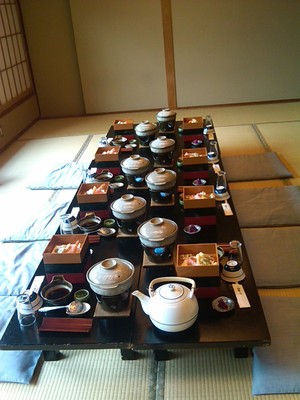 As a long time resident of a major, mid-Atlantic American city (Philadelphia), I considered myself quite cosmopolitan in terms of my exposure to foreign food, including Japanese. However, after two weeks of eating Japanese food---in Japan of all places---I realize that sushi from an American supermarket is just Japanese food lite.
As a long time resident of a major, mid-Atlantic American city (Philadelphia), I considered myself quite cosmopolitan in terms of my exposure to foreign food, including Japanese. However, after two weeks of eating Japanese food---in Japan of all places---I realize that sushi from an American supermarket is just Japanese food lite.
Several of our hotels in Japan were next to (or even attached) to a major train station. So, whereas in Philadelphia, we have never said to ourselves, "I know, let's have dinner at the train station", in Japan, train stations were one of our go-to places to find sustenance.
On our first night "in country", we walked around inside the massive main Tokyo train station and stumbled upon "Restaurant Street". The beauty of Restaurant Street in the train station was that many of the restaurants had some English translations on their menus and even better, photos of food. For the truly clueless, there were even plastic models of food. This made ordering, more or less, seamless. For example, we knew we probably did not want to request "salted fish guts of salmon's internal organs." Fortunately, there were no photos or plastic food models of this item--just the translation. When ordering in this manner, I was also mostly able to avoid ordering food that might be staring back at me. At the risk of sounding like an Ugly American, I have to admit that some of the food items happily consumed by the Japanese had me thinking about becoming a card carrying member of PETA.
We also found that there seemed to be a direct correlation between food and discomfort. The fancier the meal, the more likely we were to find ourselves having to contort our 50-something year old, inflexible bodies into painful postures to sit on tatami mats on the floor in order to reach the food on the ten inch high table. Fortunately, these restaurants also required shoes to be removed at the front door which at least prevented mutilation with spiked high heels.
In order to confirm my autonomic horror at the thought of eating raw fish and to be polite, I did actually take a bite of some raw sea creature when I accompanied my husband to a professional kaiseki dinner where he was the guest of honor. Kaiseki is a favored multi-course Japanese meal. I figured his Japanese hosts already thought he was weird just for bringing his wife. The kaiseki meal to which we were treated turned out to be seven courses of fish in various states of rawness, including a course of a semi-cooked egg and fish omelet. The last course was miso soup, rice and eel.
Much to my surprise, my husband actually developed a taste for eel. The most adventuresome I got was to order barley rice with grated yam from an English menu. Mistake. Grated yam turned out to be a bland, slimy, white paste---in this case, perched on some steamed white rice. Slimy is a texture that is well represented in Japanese cuisine.
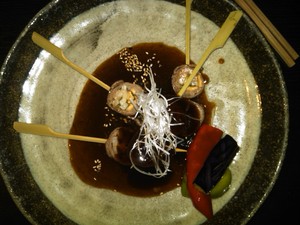
I was quite proud at one meal when I managed to conceal my dismay while my neighbor waxed eloquently about his sashimi (raw sea bream, tuna and whatever). While he consumed his slimy morsels, I happily munched on delicious well done beef wrapped around udon noodle swirls in an exquisite sauce.
Despite their fondness for raw fish, the Japanese seem to prefer their vegetables well cooked or pickled. I was familiar with mystery meat from my college cafeteria fare back in the day, but in Japan, it was often vegetable preparation that prompted a guessing game of "name that vegetable" among the gai jin (foreigners) at the table. This photo of no fewer than twelve types of pickled vegetables available for sale at a street market sort of illustrates the problem. 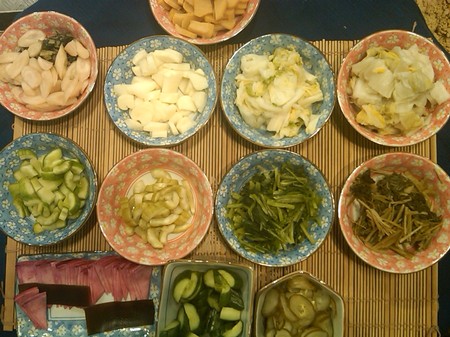
At a Zen Buddhist vegetarian lunch, I could dig in, confident that even if I had no clue as to the origin of the beautifully presented non-meat items I was eating, there were no hidden eyes---unless perhaps something was made from potato. (Get it?) 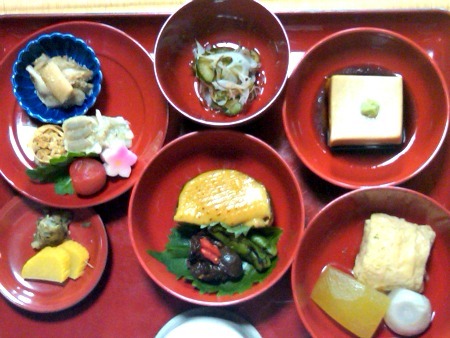
The favorite meal of our Japanese sojourn was a sukiyaki dinner at a tiny hole in the wall, one counter, mother-daughter restaurant on a back alley in Takamatsu, a city not on the usual tourist itinerary. It was difficult to find an English menu in Takamatsu, so we ended up in this place because we were able to say "sukiyaki" which produced a nod of the head and a smile as we were ushered in. Then there was the problem of figuring out what type of sukiyaki might be available. Using a smart phone translator app, we figured out that the first meat suggestion was "horse". The horrified look on my face apparently did not need translation. We had beef sukiyaki---we think.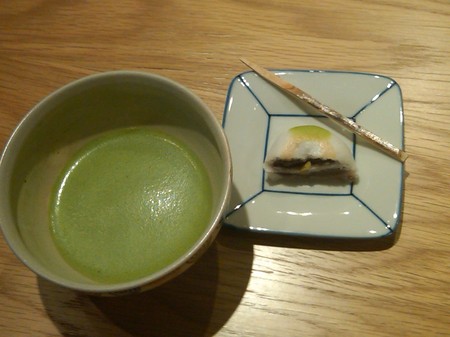
A visit to Japan would not be complete without witnessing a tea ceremony. My visit to Japan was not complete. I didn't see an actual tea ceremony, but I did try ceremonial green tea at a teahouse founded in 1717 in Kyoto. The tea is made from special powdered green tea and was served with a bean paste sweet. Verdict: the tea was way too bitter and the sweet was way too sweet. We were told that in the Zen Buddhist tradition, the two tastes are supposed to combine in one's mind. Apparently, I am simply not Zen enough to pull this off.
There don't seem to be very many obese people in Japan although it looks like residents of Tokyo might be starting to pudge up. I guess this national leanness should not be that surprising. "Salted fish guts of salmon's internal organs" is probably low cal and really, how much of it can a person eat!
[All photos by Suzanne Fluhr. A version of this essay first appeared on Boomeresque.]